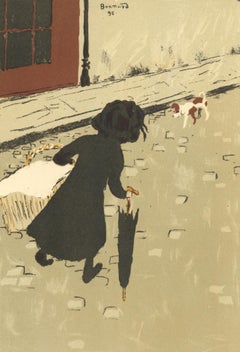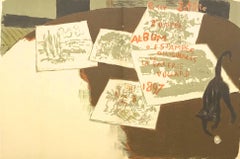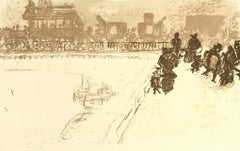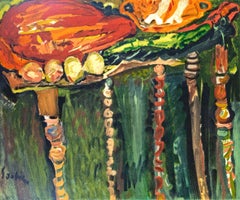Want more images or videos?
Request additional images or videos from the seller
1 of 7
Toulouse-Lautrec, Composition, The Circus by Toulouse-Lautrec (after)1952
1952
$716List Price
About the Item
- Creation Year:1952
- Dimensions:Height: 12.125 in (30.8 cm)Width: 9.25 in (23.5 cm)
- Medium:
- Movement & Style:
- After:Henri de Toulouse-Lautrec (1864 - 1901, French)
- Period:
- Condition:
- Gallery Location:Fairfield, CT
- Reference Number:1stDibs: LU1342116157412
About the Seller
4.8
Vetted Professional Seller
Every seller passes strict standards for authenticity and reliability
Established in 2002
1stDibs seller since 2020
916 sales on 1stDibs
Typical response time: 1 hour
Authenticity Guarantee
In the unlikely event there’s an issue with an item’s authenticity, contact us within 1 year for a full refund. DetailsMoney-Back Guarantee
If your item is not as described, is damaged in transit, or does not arrive, contact us within 7 days for a full refund. Details24-Hour Cancellation
You have a 24-hour grace period in which to reconsider your purchase, with no questions asked.Vetted Professional Sellers
Our world-class sellers must adhere to strict standards for service and quality, maintaining the integrity of our listings.Price-Match Guarantee
If you find that a seller listed the same item for a lower price elsewhere, we’ll match it.Trusted Global Delivery
Our best-in-class carrier network provides specialized shipping options worldwide, including custom delivery.You May Also Like
Hong Kong urbanscape lithograph
By Ramon Moscardo Fernandez
Located in Sitges, Barcelona
Josep Moscardó (1953) - Girona Cathedral
Lithograph - Hand signed
Lithograph measures 54x76 cm.
Frameless.
Numbered 12/150
Barcelona, 1953
Painter, sculptor and draftsman of deep-r...
Category
1990s Fauvist Landscape Prints
Materials
Lithograph
$382 Sale Price
46% Off
H 21.26 in W 29.93 in
Miss May Belfort
Located in Columbia, MO
HENRI DE TOULOUSE-LAUTREC
Miss May Belfort
Lithograph on paper
Ed. 166/740
20.5 x 14 inches
Category
19th Century Post-Impressionist Figurative Prints
Materials
Lithograph
Cecy Loftus
Located in Columbia, MO
HENRI DE TOULOUSE-LAUTREC
Cecy Loftus
1948
Lithograph on paper
Ed. 166/740
20.5 x 14 inches
Category
19th Century Post-Impressionist Figurative Prints
Materials
Lithograph
Etude de femme
Located in Columbia, MO
HENRI DE TOULOUSE-LAUTREC
Etude de femme
1948
Lithograph on paper
Ed. 166/740
20.5 x 14 inches
Category
19th Century Post-Impressionist Figurative Prints
Materials
Lithograph
Le Sommeil
Located in Columbia, MO
HENRI DE TOULOUSE-LAUTREC
Le Sommeil
1948
Lithograph on paper
Ed. 166/740
20.5 x 14 inches
Category
19th Century Post-Impressionist Figurative Prints
Materials
Lithograph
Blanche et Noire
Located in Columbia, MO
HENRI DE TOULOUSE-LAUTREC
Blanche et Noire
1948
Lithograph on paper
Ed. 166/740
20.5 x 14 inches
Category
19th Century Post-Impressionist Figurative Prints
Materials
Lithograph
Japanese Woodblock Artist French Lithograph Fauvist Colors School of Paris
By Shungo Sekiguchi
Located in Surfside, FL
Shungo Sekiguchi, (Japanese, 1911-2002):
Lithograph in color on Rives paper
Hand signed in pencil lower right, hand numbered
It appears to be the village of Montmarte in Paris
T...
Category
1950s Post-Impressionist Landscape Prints
Materials
Lithograph
Toulouse Lautrec Original Lithograph Famous Political 1800s Collection Signed
By Henri de Toulouse-Lautrec
Located in Milwaukee, WI
"Lautrec Book: From Au Pied du Sinai written by Georges Clemenceau" lithographs created by the legendary Henri de Toulouse-Lautrec. This book, Au Pied...
Category
1890s Post-Impressionist Figurative Prints
Materials
Lithograph, Mulberry Paper
Murmures
By Jean-Pierre Cassigneul
Located in San Francisco, CA
This art work titled "Murmures" 1989 is an original color lithograph on wove paper by French artist, Jean Pierre Cassigneul, born 1935. It is hand signed and inscribed E.A (Artist Proof) in pencil by the artist. Referenced and pictured in the artist's catalogue raisonne by Mazo. plate #31. The image size is 23.80 x 30 inches, framed size is 39.25 x 44.5 inches. Custom framed in a wooden gold frame, with fabric matting and gold color spacer. It is in excellent condition.
About the artist:
Jean-Pierre Cassigneul is a French painter known for his serene portraits of women in hats that recall the French Post-Impressionist avant-garde, including the works of Pierre Bonnard and Edouard Vuillard. He was born on July 13, 1935, in Paris.
He studied at the École des Beaux-Arts in Paris and went on to exhibit in various group exhibitions, including the Salon d' Automne in Paris (of which he was member), the Salon de la Jeune Peinture, He exhibited at the Beaubourg Center in Paris in 1977 and solo as of 1952, on a regular basis in France but also in New York, and Tokyo and worldwide
Jean PierreCassigneul is known for his charming and extremely popular Van Dongen-influenced paintings of women in floral hats, complete with frequent allusions to other aspects of the Années Folles.
1952 First private exhibition at the Galerie Lucy Kroge in Paris aged 17.
1954 Enters into the Académie Charpentier and then decides to study under Jean Souverbie
at the Ecole des Beaux-Arts de Paris.
1955 He passes his entrance exam a year later and enrolls at the "Ecole Nationale Superieure"
des Beaux-Arts de Paris. Works in Chapelain-Midy’s studio.
1958 First exhibition at the Galerie des Beaux-Arts.
1959 Appointed member of the Salon d’Automne.
1956–1960 Instructed by the French painter Roger Chapelain-Midy.
1963 Present at the Salon de la Jeune Peinture for the first time.
1964 Private exhibition at the Galerie Tivey-Faucon, Paris.
Meets Kiyoshi Tamenaga, who becomes his art dealer for Japan.
1965 Creation of his first lithographic works.
Exhibition at the Galerie Bellechasse, Paris.
1966 Present at the International Exhibition of Figurative Art, Tokyo.
Exhibition at the Galerie Bellechasse, Paris.
1968 Exhibition at the Galerie Juarez in Palm Beach, USA.
Private exhibition at la Galerie Vital, Paris.
1969 Exhibition of lithographic works at the Mitsukoshi Gallery, Tokyo.
1970 January : Exhibition at the Wally Findlay Gallery, Palm Beach, then in New York.
First trip to Japan, where he stays for three months.
Important private exhibition at the Mitsukoshi Gallery, Tokyo.
1973 Exhibition at the Wally Findlay Gallery in Palm Beach, then in New York.
Private exhibition at the Tamenaga Gallery, Tokyo. Meets art publisher Alain Mazo.
1974 Private exhibition at the Galerie Wally Findlay, Paris, then in New York.
1975 Exhibition at the Wally Findlay Gallery, New York.
1976 Private exhibition at the Mitsukoshi Gallery, Tokyo.
Publication of the album “Parcs” by Editions Mazo-Paris.
1977 June : Private exhibition at the Galerie René Kieffer, Paris
Private show of paintings and pastels at the Galerie Wally Findlay, Paris.
1978 Retrospective exhibition of lithographic works at Vision Nouvelle.
June-July : Exhibition at the Wally Findlay Gallery, New York.
Important private showat the Mitsukoshi Gallery, Tokyo.
1980 Designs his first tapestry, executed by Atelier 3...
Category
Late 20th Century Post-Impressionist Figurative Prints
Materials
Lithograph
Femme a l'ombrelle
By Jean-Pierre Cassigneul
Located in San Francisco, CA
This art work titled "Femme a l'Ombrelle" 1972 is an original color lithograph on Arches paper by French artist, Jean Pierre Cassigneul, born 1935. It is hand signed and numbered 29/150 in pencil by the artist. Referenced and pictured in the artist's catalogue raisonne by Sauret plate #42. The image size is 22.25 x 16 inches, framed size is 36.15 x 28.25 inches. Custom framed in a wooden gold leaf frame, with fabric matting and gold color spacer. It is in excellent condition.
About the artist:
Jean-Pierre Cassigneul is a French painter known for his serene portraits of women in hats that recall the French Post-Impressionist avant-garde, including the works of Pierre Bonnard and Edouard Vuillard. He was born on July 13, 1935, in Paris.
He studied at the École des Beaux-Arts in Paris and went on to exhibit in various group exhibitions, including the Salon d' Automne in Paris (of which he was member), the Salon de la Jeune Peinture, He exhibited at the Beaubourg Center in Paris in 1977 and solo as of 1952, on a regular basis in France but also in New York, and Tokyo and worldwide
Jean PierreCassigneul is known for his charming and extremely popular Van Dongen-influenced paintings of women in floral hats, complete with frequent allusions to other aspects of the Années Folles.
1952 First private exhibition at the Galerie Lucy Kroge in Paris aged 17.
1954 Enters into the Académie Charpentier and then decides to study under Jean Souverbie
at the Ecole des Beaux-Arts de Paris.
1955 He passes his entrance exam a year later and enrolls at the "Ecole Nationale Superieure"
des Beaux-Arts de Paris. Works in Chapelain-Midy’s studio.
1958 First exhibition at the Galerie des Beaux-Arts.
1959 Appointed member of the Salon d’Automne.
1956–1960 Instructed by the French painter Roger Chapelain-Midy.
1963 Present at the Salon de la Jeune Peinture for the first time.
1964 Private exhibition at the Galerie Tivey-Faucon, Paris.
Meets Kiyoshi Tamenaga, who becomes his art dealer for Japan.
1965 Creation of his first lithographic works.
Exhibition at the Galerie Bellechasse, Paris.
1966 Present at the International Exhibition of Figurative Art, Tokyo.
Exhibition at the Galerie Bellechasse, Paris.
1968 Exhibition at the Galerie Juarez in Palm Beach, USA.
Private exhibition at la Galerie Vital, Paris.
1969 Exhibition of lithographic works at the Mitsukoshi Gallery, Tokyo.
1970 January : Exhibition at the Wally Findlay Gallery, Palm Beach, then in New York.
First trip to Japan, where he stays for three months.
Important private exhibition at the Mitsukoshi Gallery, Tokyo.
1973 Exhibition at the Wally Findlay Gallery in Palm Beach, then in New York.
Private exhibition at the Tamenaga Gallery, Tokyo. Meets art publisher Alain Mazo.
1974 Private exhibition at the Galerie Wally Findlay, Paris, then in New York.
1975 Exhibition at the Wally Findlay Gallery, New York.
1976 Private exhibition at the Mitsukoshi Gallery, Tokyo.
Publication of the album “Parcs” by Editions Mazo-Paris.
1977 June : Private exhibition at the Galerie René Kieffer, Paris
Private show of paintings and pastels at the Galerie Wally Findlay, Paris.
1978 Retrospective exhibition of lithographic works at Vision Nouvelle.
June-July : Exhibition at the Wally Findlay Gallery, New York.
Important private showat the Mitsukoshi Gallery, Tokyo.
1980 Designs his first tapestry, executed by Atelier 3...
Category
Late 20th Century Post-Impressionist Figurative Prints
Materials
Lithograph
More From This Seller
View AllBonnard, La Petite Blanchisseuse, Bonnard Lithographe (after)
By Pierre Bonnard
Located in Fairfield, CT
Medium: Lithograph on grand vélin Renage filigrané paper.
Year: 1952
Paper Size: 12.5 x 9.5 inches; image size: 9.45 x 6.69 inches
Inscription: Signed in the plate and unnumbered, as...
Category
1950s Post-Impressionist Figurative Prints
Materials
Lithograph
$716 Sale Price
20% Off
Bonnard, Couverture, Bonnard Lithographe (after)
By Pierre Bonnard
Located in Fairfield, CT
Medium: Lithograph on grand vélin Renage filigrané paper.
Year: 1952
Paper Size: 9.5 x 25 inches, with centerfold, as issued
Inscription: Unsigned and unnumbered, as issued
Notes: Fr...
Category
1950s Post-Impressionist Figurative Prints
Materials
Lithograph
$716 Sale Price
20% Off
Bonnard, Le Pont des Arts, Bonnard Lithographe (after)
By Pierre Bonnard
Located in Fairfield, CT
Medium: Lithograph on grand vélin Renage filigrané paper.
Year: 1952
Paper Size: 9.5 x 12.5 inches; image size: 7.08 x 11.02 inches
Inscription: Unsigned and unnumbered, as issued
No...
Category
1950s Post-Impressionist Figurative Prints
Materials
Lithograph
$716 Sale Price
20% Off
Soutine, Morte Au Morceau, Soutine, Collection Pierre Lévy (after)
Located in Fairfield, CT
Medium: Lithograph on vélin d'Arches paper
Year: 1966
Paper Size: 20 x 26 inches
Inscription: Signed in the plate and unnumbered, as issued
Notes: From the folio, Soutine, I, Collect...
Category
1960s Post-Impressionist Landscape Prints
Materials
Lithograph
$716 Sale Price
20% Off
Bonnard, L´Enfant a la lampe, Bonnard Lithographe (after)
By Pierre Bonnard
Located in Fairfield, CT
Medium: Lithograph on grand vélin Renage filigrané paper.
Year: 1952
Paper Size: 9.5 x 12.5 inches; image size: 7.87 x 10.63 inches
Inscription: Unsigned and unnumbered, as issued
No...
Category
1950s Post-Impressionist Figurative Prints
Materials
Lithograph
$716 Sale Price
20% Off
Bonnard, Dans la Rue, Bonnard Lithographe (after)
By Pierre Bonnard
Located in Fairfield, CT
Medium: Lithograph on grand vélin Renage filigrané paper.
Year: 1952
Paper Size: 12.5 x 9.5 inches; image size: 8.66 x 4.72 inches
Inscription: Unsigned and unnumbered, as issued
Not...
Category
1950s Post-Impressionist Figurative Prints
Materials
Lithograph
$716 Sale Price
20% Off



